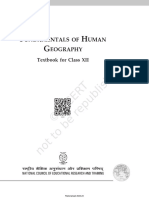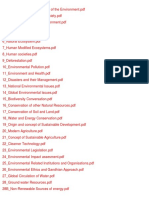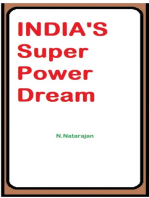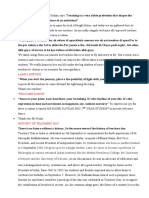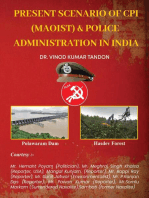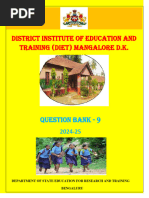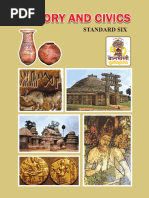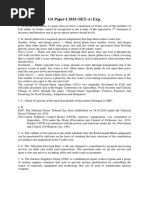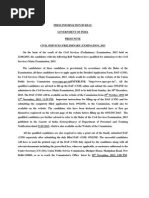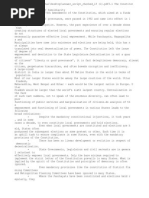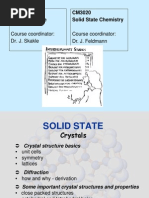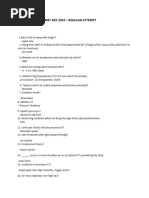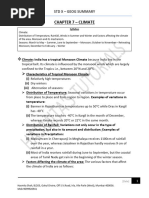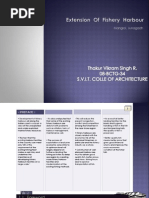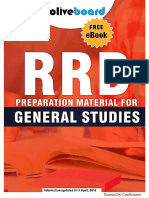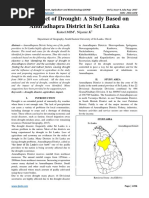Geography of India A Samudra
Geography of India A Samudra
Uploaded by
Alpesh PanchalCopyright:
Available Formats
Geography of India A Samudra
Geography of India A Samudra
Uploaded by
Alpesh PanchalOriginal Title
Copyright
Available Formats
Share this document
Did you find this document useful?
Is this content inappropriate?
Copyright:
Available Formats
Geography of India A Samudra
Geography of India A Samudra
Uploaded by
Alpesh PanchalCopyright:
Available Formats
Published By
Sau. Shobhadevi Kshirsagar
KSagar Publications
Suvarna Shilpa, 444/1 Shaniwar Peth, Adjacent to Rajmachikar Flour Mill, Near Dakshinabhimukhi Maruti Temple, Pune - 411 030 : 24450125, 24455435 Fax : 91-020-24453065 Email : K_Sagar_v@vsnl.net m K'Sagar Publications, Pune Copy-rights reserved & registered as per the Act. First Edition : 2008 m
Printed at
Step-in Services 1311, Kasba Peth, Pune - 411 011 m
Typesetting
K'Sagar Publications, Pune m
Cover Design
K'Sagar Publications, Pune m
Price : Rs. 200/-
123456789012345678901234567890121234567890 Our Firms 123456789012345678901234567890121234567890 123456789012345678901234567890121234567890 123456789012345678901234567890121234567890 K'Sagar's House of Books, K'Sagar Book Centre, 123456789012345678901234567890121234567890 Durga Chambers, 39/1 Budhwar Nutan Classic, 639, Narayan Peth, 123456789012345678901234567890121234567890 123456789012345678901234567890121234567890 Peth, Jogeshwari Temple Marg, S Opp. N.M.V. Primary School, 123456789012345678901234567890121234567890 Appa Balwant Chowk, Appa Balwant Chowk, 123456789012345678901234567890121234567890 123456789012345678901234567890121234567890 24483166 Pune - 411 002 24453065 Pune - 411 030. 123456789012345678901234567890121234567890 123456789012345678901234567890121234567890 All rights are reserved. No part of this version may be reproduced, 123456789012345678901234567890121234567890 123456789012345678901234567890121234567890 stored in a retrieval system or transmitted, in any form or by any 123456789012345678901234567890121234567890 123456789012345678901234567890121234567890 means, mechanical, photocopying, recording or otherwise, without 123456789012345678901234567890121234567890 prior written permission of the publishers. 123456789012345678901234567890121234567890 123456789012345678901234567890121234567890
MPSC and the recruitment examinations conducted by it are held in a very high esteem in the entire state. The subject of geography holds a special place in the examination syllabus of the MPSC. We at KSagar Publications take a great pleasure in introducing a handy, comprehensive and highly detailed reference book Geography of India for the candidates of MPSC and specially for those who are appearing for State Services Main Exam and facing the new & vast syllabus.While covering the entire prescribed syllabus of geography for the said examination, we have taken every care to include the most authenticated and latest official data in this book. The book has many maps, tables and diagrams in order to illustrate the subject matter and the data that has been provided. These illustrations explain the topics in a comprehensive manner while making the vast data easy to understand and remember. The entire content of the book has been verified for its matter as well as the accuracy of the text. I as a writer have tried in my best capacity to make the book a gamut of facilities for the students to be availed under one roof. This is because, I am aware that as a student how difficult it is to hunt for the topics for a particular exam, in various books at the same time. To overcome this difficulty of multiple referencing and the resultant confusion of the students, all the prescribed topics have been covered meticulously in every minute detail. The initial three chapters of the book give introduction of the position of our motherland India in the world setup. The first three chapters have been dedicated fully only to the introduction of India, in order to maintain a continuity and flow of the subject matter. The fourth chapter introduces the state of Maharashtra to you. The chapter gives an idea about the physical and the social position of the state in the country. The fifth and the sixth chapter are also dedicated to the state. Again the order and the continuity of the subject matter are maintained by arranging the three chapters in a continuous order. The eighth chapter discusses the climatic setup of the country as well as the state. This chapter also explains the concept of the agroclimatic zones of the country as well as the state. The various natural resources in the country and in the state of Maharashtra have been discussed from all aspects from the ninth chapter onwards. Here, a particular order has been maintained in the chapters, whereby the resources of the country are discussed first, followed by those of the state. The chapter of tourism has been introduced as a wholesome
unit in this book. The last chapter gives the details of the districts of Maharashtra at a glance. Towards the end I would like to thank all those people who have made the dream venture of writing this reference book come true. The first thanks go to KSagar Publications and Shri. Kshirsagar Sir for showing the faith in me and bearing with all my problems and also the delays caused due to these problems. His kind co-operation and helping nature have been greatest driving forces in making the book an accomplishment. He is very particular about the authenticity of the data, but at the same time he gives the writers freedom of expressing the subject matter in their own style. The confidence shown by him proved to be a source of inspiration to me and I must say that this will remain so even in the future. I also thank the entire staff at KSagar for all the help and co-operation they have lent to me during the publishing of the book. Their responsible attitude and neatness of the work are highly respectable. They all have played a very important role in the publication of this book. My special thanks to all the government officials who went out of their way to help me obtain the latest authenticated data to be included in the book. Special thanks go to the officials of the forest department and Shri. Abhay Yawalkar then joint MD of MTDC for providing me with all the information about the various programmes and the material related to them. I must thank Smt. Sangeeta Bhalerao for all the enthusiastic support of hers in this venture of mine. Her bubbling energies are worth a special applause. I would also like to take this opportunity to thank the staff of our own company for all the help they have given me in the initial stages of this book. Thanks are due to them for their dedicated help and efforts. Last but not at all the least, I take the greatest pleasure in thanking my family for all that they have done for me. It is for their support and encouragement that I could manage to complete this book. My husband Dinesh and son Rohan deserve a special mention and applause for their understanding and forbearance. I consider myself to be very lucky to have a family that not only inculcates but also rears good qualities in its members. Words can never express the gratitude that I feel towards all of them. I need to make a special mention of my father Late Shri. Vinayak Deo, who was an expert in geography and a born teacher. He has been the real source of inspiration for me in achieving greater heights in the fields of geography and education. He has blessed me with his qualities of perseverance and hard work. All my friends are also equally important to me as they have always shown great appreciation towards my work which was another driving force for me. I am sure that this book will prove to be of good help for the students of MPSC. Any mistake that has gone unnoticed is apologized for and suggestions for the improvements in the book are most welcome. Archana Samudra
8 . Climate of Maharashtra
1 . India Location and Extent
I Location and Extent of India
9 .
16
2 . Physiographic Divisions
I I I I I I I I The Peninsular Plateau The Northern Mountainous Region (Himalayas) The North Indian Plains The Coastal Plains I The Indian Islands
10.
39
3 . Rivers and Lakes
The Himalayan Rivers I The Peninsular Rivers Drainage Patterns in India I River Regimes Lakes of India I Flood Problems Pollution of the river
4 . Maharashtra Introduction
I Evolution of Maharashtra I The Nag-Vidarbha Movement
74
5 . Maharashtra Physiographical Details
I I I I I I
82
Regional Divisions Some Salient Features of Maharashtra State Geology of Maharashtra I The Konkan Coastal Strip The Sahyadris and other hills of Maharashtra The Plateau Region I Geological Structure of India Geological structure of Maharashtra 6 . Water Resources in Maharashtra 107 I The rivers of the Maharashtra Plateau I Lakes and Wells of Maharashtra 7 . Climate 115 I Climate of India I Factors Influencing the Climate I The Hot Period or the Summer Season I The Rainy or the Monsoon Season I The Arabian Sea Branch I The Bay of Bengal Branch I The Period of Retreating Monsoon I Distribution of Rainfall in India I The Cold Season or the Winter Season
11.
12.
139 I Seasons in Maharashtra I India : Agro-Climatic Zones I Maharashtra : Agro-Climatic Zones I Types of Farming I The Agricultural Regions of Maharashtra Natural Resources 157 I Types of Soil I Types of Erosion I Soils of Maharashtra I Soil Degradation in Maharashtra Natural Vegetation 184 I Moist tropical forests I Dry tropical forests I Mountainous sub-tropical forests I Mountainous temperate forests I Classification for administrative purposes I Forest products and their economic importance I Protective functions of the forests I Making the soil more fertile I Conservation of forests I Indian wildlife I Natural Vegetation of Maharashtra I Classification according to types I Forest products of maharashtra I Industries based on forest products I State of the forests in Maharashtra I Social Forestry I Wildlife in Maharashtra I Droughts I Effects of drought I Drought Prone Areas I Management of Drought I Droughts in Maharashtra Mineral Wealth of India 246 I The Major Mineral Belts of India I Metallic Minerals I Non-Metallic Minerals I Mineral Resources in Maharashtra India : Energy Resources 266 I Coal I Conservation of Coal I Electricity I Important Hydroelectric Plants in Different States of India I Thermal Electricity I Major Thermal Power Stations in India I Nuclear Energy I Non-conventional Energy Resources I Wind Power Potential I Biogas I Energy Resources in Maharashtra I Coal
I I I I
Mineral Oil I Deposits of mineral oil in the state Natural Gas I Thermal Power I Hydel Power Important Hydel Power Projects in the State Nuclear Power I Non-conventional Power Sources
13. India : Population
303 I Population of Major Countries (Comparison with India) I Some basic concepts related to population I Distribution of Indian Population I Density of Population I Increase in Density of Population of India I Characteristics of the Indian Population I Literacy 14. Maharashtra : Population 331 I Density of Population in the State I Migration of Population in Maharashtra I Rural Population of Maharashtra I Rural Settlements I Rural Houses and House Types I Urban population in Maharashtra I Growth of Urbanisation by Class of Town I India : Class-wise Number of Towns and Cities and their Population, 2001 I Distribution of Urban Populatioin in India : 2001 I Problems related to urbanization I Population and Slum Population in million plus cities (Municipal Corporation : 2001) I Urban Crimes 15. Tourism 369 I Growth of Tourism in India I Problems related to the Tourism Sector I Prospects of Tourism in India I Tourism in Maharashtra 16. Districts of Maharashtra 391 I Thane I Raigad I Ratnagiri I Sindhudurg I Pune I Satara I Sangli I Kolhapur I Solapur I Nashik I Ahmednagar I Dhule I Nandurbar I Jalgaon I Aurangabad I Jalna I Beed I Parbhani I Hingoli I Osmanabad I Latur I Nanded I Buldhana I Akola I Washim I Amravati I Wardha I Yavatmal I Nagpur I Bhandara I Gondia I Chandrapur I Gadchiroli I Mumbai & Mumbai Suburb
12345678901234567890 12345678901234567890 12345678901234567890 12345678901234567890 12345678901234567890
1. India A Comprehensive Geography - Khullar 2. Systematic Agricultural Geography - Majid Husain 3. India 2007 - Information and Broadcasting Ministry Publication 4. Economic Survey - 2006-07 - Ministry of Finance 5. Maharashtracha Bhoogol - K. A. Khatib (KSagar Publications) 6. Assa Ha Maharashtra - KSagar (KSagar Publications) 7. Economic Geography - Hartshorn & Alexander 8. Geography of Maharashtra - C. D. Deshpande 9. General Geography of India - Padey & Fernandes 10. Principles of Physical Geography - Padey & Fernandes 11. Krishi Diary 2005 - Agricultural Ministry (Maharashtra State) 12. FSI - State of the Forest Report - 2005 - Forest Ministry (M. S.) 13. Maharashtratil Zille - KSagar (KSagar Publications) 14. A Modern Dictionary of Geography - K. Siddartha & S. Mukherjee 15. Chaus Dictionary 16. Bhoogol Shastra Paribhashakosh - Maharashtra Government 17. Different text books on geography 18. Information literature published by MTDC 19. Nisargvani - Dept of Social Forestry (Maharashtra State) 20. Competition Wizard - December, 2006 Issue
Archana Samudra. An enthusiastic youth of 35 Yrs. with a studious despotism, having done her gradution in Science B.Sc. & post gradution in education M.Ed. Comparing to her age, she has a vast experience of 14 yrs. of teaching. During a period 1994 onwards she has worked in various English medium Schools like Loyola School, Kathmandu, Nepal and taught various subjects like Maths, Science, English, Social studies and ofcourse, Geography. At present she is working with Sevasadan English Medium School, Pune. Her present work Geography of India with special reference to Maharashtra is a first, only and unique reference on a new syllabus of General Studies paper I, part B of the State Services Main Examination. It was a keen desire of English medium students that comprehensive reference on the above said syllabui should be published by the KSagar Publications.Since proper references on the subject matter were not available and since the subject matter requires a lot of data, accurate and recent figures and knowledge of some technical terms and concepts it was not easy task to write on this subject. On this background it must be said that Archana Samudra has carried out this difficult task in commendable manner and demonstrated her command of the subject. She has taken lot of pains and made keen efforts to make visualise this architect. Mrs. Samudra has in her language easy to understand, made the subject itself easy. She has given justice to the subject matter and considered the need of the students. I hope this work will not only be admired by the students but will be proved a prime work a master pice on the subject. I Hope that students will welcome this esteem work and this work will prove extremely useful for them and pave their way to success. Thanks and best of Luck. V. S. Kshirsagar (KSagar)
Archana Dinesh Samudra, B.Sc., M.Ed.
Experience Teaching experience of nearabout 14 yrs. in various English medium schools including Loyola School, Kathmandu & Sevasadan English medium School, Pune.
Connected Activities
1. Giving special tuitions for Geography students of 8th, 9th & 10th and training them for projects. 2. Author of books based on CBSE syllabus for Environmental Studies, Mathematics, for classes 3rd and 4th. 3. Writing articles in Daily Sakal for Dahavichi Tayari on Geography & Economics. 4. Written articles for Dahavi Diwali on techniques of writing SSC Board Papers (Geography) for Year 2006-07 and currently writing for 10th Scanner & Guide. 5. Writing Model Solutions for Paper Sets of Dahavi Diwali. 6. Written articles for Sakal Pattern 8th & 9th Standards Geography & Economics for Year 2006-07 and currently writing for Year 2007-08, for Standard 9th & 10th. 7. Visiting expert to various schools in Pune for guidance of students appearing for SSC board exams Subject Social Studies. 8. Give special guidance to 10th Std. students for Geography/Economics in person 9. Expert on geography for checking the paper sets and their solutions for SSC board Publications like Dahad Vidyavardhini. Social Activities 1. Concerned about child education in the lower strata of the society. Trying to reach in person wherever possible by sponsoring education of such students on personal level. 2. Giving importance to girls education. Sponsoring girls education on personal level. 3. Tutoring students of the lower economic groups as a social responsibility so that they fare well in their educational career. 4. Sponsored a library of a school in the rural area of Solapur.
You might also like
- PMF Geography 2024 EditionDocument273 pagesPMF Geography 2024 EditionPratik Mishra100% (5)
- Booklist Shubham Kumar PDFDocument11 pagesBooklist Shubham Kumar PDFVivek VishwakarmaPSH'076100% (1)
- Translation of Goswami Harirai's Jarasandhavadha MahakavyamDocument287 pagesTranslation of Goswami Harirai's Jarasandhavadha MahakavyamRamanasarmaNo ratings yet
- Class XII - India People & Economy (Geography)Document161 pagesClass XII - India People & Economy (Geography)Mantra67% (3)
- Upsc Mains GS Paper 2 SyllabusDocument10 pagesUpsc Mains GS Paper 2 SyllabusNaveenNo ratings yet
- 12th Social-geography-India People and EconomyDocument185 pages12th Social-geography-India People and Economyanon_235844751No ratings yet
- Preparing For Civil Services ExaminationDocument125 pagesPreparing For Civil Services ExaminationErik MarksNo ratings yet
- Newslive 23rdfeb2014 Telangana KilliDocument20 pagesNewslive 23rdfeb2014 Telangana KillideekshithNo ratings yet
- NCERT 12th Fundamentals of Human GeographyDocument92 pagesNCERT 12th Fundamentals of Human Geographyprep8910No ratings yet
- Part 5 - Indian Constitution Class Notes For Civil Services in Telugu Medium - APPSC Material, Group 1 Group 2 Notification, UPSC, Bank PO, IBPS, General Studies MaterialDocument27 pagesPart 5 - Indian Constitution Class Notes For Civil Services in Telugu Medium - APPSC Material, Group 1 Group 2 Notification, UPSC, Bank PO, IBPS, General Studies MaterialPaddireddySatyam100% (1)
- Structure of Indian SocietyDocument151 pagesStructure of Indian Societydmugundhan100% (3)
- Old NCERT World History Ch12Document208 pagesOld NCERT World History Ch12Aarti KumariNo ratings yet
- Geography Optional Strategy by Pratham Kaushik Air 5 Cse 2017 327 MarksDocument10 pagesGeography Optional Strategy by Pratham Kaushik Air 5 Cse 2017 327 MarksPrasanth mallavarapuNo ratings yet
- IAS4Sure Environment Notes For Prelims 2017Document35 pagesIAS4Sure Environment Notes For Prelims 2017Sau RabhNo ratings yet
- History Class11 TN BoardDocument150 pagesHistory Class11 TN BoardamitNo ratings yet
- GEOGRAPHY (Opt.) PAPER-I-2Document33 pagesGEOGRAPHY (Opt.) PAPER-I-2ministryofdefenceahfqNo ratings yet
- Toolkit For csp22: Strategic Guidance Document For Last 125 DaysDocument15 pagesToolkit For csp22: Strategic Guidance Document For Last 125 DaysAyush BhadauriaNo ratings yet
- Class XI-Fundamental of Physical GeographyDocument145 pagesClass XI-Fundamental of Physical GeographyMantra100% (1)
- Mains Syllabus, Booklist & SourcesDocument6 pagesMains Syllabus, Booklist & SourcesPratyush SahuNo ratings yet
- Biodiversity UPSC Notes GS IIIDocument3 pagesBiodiversity UPSC Notes GS IIIHarsha SekaranNo ratings yet
- La Ex Ancient History Ready Reckoner RRP 2020 PDFDocument35 pagesLa Ex Ancient History Ready Reckoner RRP 2020 PDFNitesh PridarshiNo ratings yet
- 2019 Environment PDFDocument164 pages2019 Environment PDFBiswajit BeheraNo ratings yet
- General Studies: Reference List of Books For Prelims and MainsDocument4 pagesGeneral Studies: Reference List of Books For Prelims and MainsMohammed AyazNo ratings yet
- (CAPF Lady Topper) Tanu Shree Pareek Rank 194 - BDocument30 pages(CAPF Lady Topper) Tanu Shree Pareek Rank 194 - Bsharad gupta100% (1)
- Sunya Science and TechDocument240 pagesSunya Science and TechSubhalaxmi MohantyNo ratings yet
- APPSC Group 1 Mains Geography - PYQDocument15 pagesAPPSC Group 1 Mains Geography - PYQDevaraj BillaNo ratings yet
- Geo C11 India Physical EnvironmentDocument109 pagesGeo C11 India Physical Environmentkane21232874No ratings yet
- Environment and EcologyDocument108 pagesEnvironment and EcologyShreya SwapnilNo ratings yet
- Anthropology Optional Question Paper With Topic Wise 1981 - 2021Document107 pagesAnthropology Optional Question Paper With Topic Wise 1981 - 2021Guru BasavarajNo ratings yet
- Study of Indian Society and CultureDocument18 pagesStudy of Indian Society and CultureDrYounis ShahNo ratings yet
- Achievements of India in Science and Technology 19Document2 pagesAchievements of India in Science and Technology 1920309 KarthikNo ratings yet
- Merged 4 Min 1 1 PDFDocument1,428 pagesMerged 4 Min 1 1 PDFADITYA SINGHNo ratings yet
- TGPSC Group-1 Mains Test Series 2024 - Detailed ScheduleDocument8 pagesTGPSC Group-1 Mains Test Series 2024 - Detailed Schedulecogni 14No ratings yet
- Nios Environment Material Mrunal OrgDocument643 pagesNios Environment Material Mrunal OrgVinod KumarNo ratings yet
- Anthropology: DR Arjun Bopanna Bangalore Ias AcademyDocument10 pagesAnthropology: DR Arjun Bopanna Bangalore Ias AcademyBibilNo ratings yet
- Biology: Textbook For Class XiiDocument9 pagesBiology: Textbook For Class XiiswaroopsorenNo ratings yet
- The Tribes and Castes of the Central Provinces of India, Book IIFrom EverandThe Tribes and Castes of the Central Provinces of India, Book IINo ratings yet
- Script AnchoringDocument5 pagesScript AnchoringAkshata BansodeNo ratings yet
- Irshad Ahmed Thesis CompletDocument45 pagesIrshad Ahmed Thesis CompletAbrar Ahmed KhanNo ratings yet
- Present scenario of CPI (Maoist) and Police Administration in IndiaFrom EverandPresent scenario of CPI (Maoist) and Police Administration in IndiaNo ratings yet
- 9thEnglishSL kpq24Document48 pages9thEnglishSL kpq24habhishek549No ratings yet
- 8thEnglishSL kpq24Document43 pages8thEnglishSL kpq24habhishek549No ratings yet
- COVER PRABA BASKARA NASUTION Compressed (1)Document14 pagesCOVER PRABA BASKARA NASUTION Compressed (1)Baskara nstNo ratings yet
- A Description of Mepasah Ceremony in Folklore Bau Wangi Taru Menyan Trunyan VillageDocument57 pagesA Description of Mepasah Ceremony in Folklore Bau Wangi Taru Menyan Trunyan Villageanggara100% (1)
- VI MATHEMATICS BL Semester - 1Document91 pagesVI MATHEMATICS BL Semester - 1svenkatk737No ratings yet
- Srimathi’s Electrotherapeutic Agents Manual PhysioMasudDocument268 pagesSrimathi’s Electrotherapeutic Agents Manual PhysioMasudeoeltt78No ratings yet
- An Analysis of Students' Difficulties in Writing Descriptive Text at The First Grade of Sman 1 Kuala KamparDocument73 pagesAn Analysis of Students' Difficulties in Writing Descriptive Text at The First Grade of Sman 1 Kuala KamparMuhammad FarhanNo ratings yet
- 4 Maths SEM-1 Textbook Compressed Tlm4allDocument150 pages4 Maths SEM-1 Textbook Compressed Tlm4allTeja TejNo ratings yet
- WRITING SKILLS PRACTICEDocument18 pagesWRITING SKILLS PRACTICEjuliaajames2007No ratings yet
- 5em EvsDocument194 pages5em EvsnagasmsNo ratings yet
- STD 6 Notes PaperDocument90 pagesSTD 6 Notes PaperAshwin MandaleNo ratings yet
- Class 6 HistoryDocument66 pagesClass 6 HistoryMahesh Gavasane100% (2)
- Skripsi Icebreaker PDFDocument107 pagesSkripsi Icebreaker PDFHira Tri Windasari IlhamNo ratings yet
- 703000584Document100 pages703000584indraNo ratings yet
- Flowering Trees in India (By Dr. MS Randhawa)Document202 pagesFlowering Trees in India (By Dr. MS Randhawa)Gary Bhullar100% (1)
- Q 1 - Principle, Procedure, Advantage, Limitation and Application of Magnetic Particle Test?Document10 pagesQ 1 - Principle, Procedure, Advantage, Limitation and Application of Magnetic Particle Test?Alpesh PanchalNo ratings yet
- GS-II Governance, Constitution, Polity, Social Justice and International RelationsDocument4 pagesGS-II Governance, Constitution, Polity, Social Justice and International RelationsAlpesh PanchalNo ratings yet
- Assignment Day1 - Alpesh PanchalDocument5 pagesAssignment Day1 - Alpesh PanchalAlpesh PanchalNo ratings yet
- SDGBDocument7 pagesSDGBAlpesh PanchalNo ratings yet
- GSPaper IExplanationSET ADocument11 pagesGSPaper IExplanationSET AAlpesh PanchalNo ratings yet
- UPSC Result 2015Document43 pagesUPSC Result 2015Vishal KumarNo ratings yet
- Common IssuesDocument26 pagesCommon IssuesAlpesh PanchalNo ratings yet
- Void Float: "Enter The Values of Cost Price and Selling Price/n" "%X" "X %X"Document1 pageVoid Float: "Enter The Values of Cost Price and Selling Price/n" "%X" "X %X"Alpesh PanchalNo ratings yet
- Toollife CDocument1 pageToollife CAlpesh PanchalNo ratings yet
- Application Form: Common Membership For (Please Tick - /)Document10 pagesApplication Form: Common Membership For (Please Tick - /)Alpesh PanchalNo ratings yet
- PX3012 The Solid State CM3020 Solid State ChemistryDocument19 pagesPX3012 The Solid State CM3020 Solid State ChemistryAlpesh PanchalNo ratings yet
- Thermodynamic Systems and ProcessesDocument18 pagesThermodynamic Systems and ProcessesAlpesh PanchalNo ratings yet
- Indian Institue of Technology BombayDocument2 pagesIndian Institue of Technology BombayAlpesh PanchalNo ratings yet
- Social StudiesDocument14 pagesSocial StudiesrakhshaaltairNo ratings yet
- Third Periodical Test in Science VIDocument3 pagesThird Periodical Test in Science VIKian Alquilos83% (6)
- IGCSE-Climate - Crash CourseDocument6 pagesIGCSE-Climate - Crash Coursezunaira babarNo ratings yet
- Discursive PassagesDocument10 pagesDiscursive Passagesshoaibmir140No ratings yet
- Met CPL Exam Written Dec 2023 2Document4 pagesMet CPL Exam Written Dec 2023 2Arnav KapoorNo ratings yet
- 130 2 PDFDocument15 pages130 2 PDFChandan Prasad KushwahaNo ratings yet
- Chapter 7 - Climate - SummaryDocument3 pagesChapter 7 - Climate - Summarymail2shanthithevarNo ratings yet
- India Climate Notes BKLDocument12 pagesIndia Climate Notes BKLchivukula Karthik100% (1)
- Effects of Weather Systems in The PhilippinesDocument19 pagesEffects of Weather Systems in The PhilippinesCaloykOoy Danday Dueñas100% (1)
- Actual Test Mock Test 1124Document12 pagesActual Test Mock Test 1124PunitNo ratings yet
- ENGLISH Grade EightDocument37 pagesENGLISH Grade EightC Salaan McdNo ratings yet
- Resort With Meditation CentreDocument6 pagesResort With Meditation CentreBoj ZcurNo ratings yet
- Brahmaputra Rivers ProfileDocument56 pagesBrahmaputra Rivers ProfileBilal A BarbhuiyaNo ratings yet
- Module 7. Reading: Sally (On The Phone) : KateDocument8 pagesModule 7. Reading: Sally (On The Phone) : KateNikita NikolaevNo ratings yet
- Weather ForecastDocument16 pagesWeather ForecastRenz Angel M. RiveraNo ratings yet
- The Thar Desert and Its AntiquityDocument9 pagesThe Thar Desert and Its Antiquityxotedeb363No ratings yet
- Mangrol Fishery HarbourDocument32 pagesMangrol Fishery HarbourVikram ThakurNo ratings yet
- 6984645-10 Prelim-1 - Sample Paper 1Document6 pages6984645-10 Prelim-1 - Sample Paper 1Sarita BishiNo ratings yet
- GS RRB Eng Railway Exam PDFDocument75 pagesGS RRB Eng Railway Exam PDFPrabhatNo ratings yet
- MCQ Geography 2Document34 pagesMCQ Geography 2Harshwardhan UndeNo ratings yet
- Geography Chapter 5 Natural Vegetation and Wildlife Class 9 Notes PDFDocument10 pagesGeography Chapter 5 Natural Vegetation and Wildlife Class 9 Notes PDFritik79079No ratings yet
- Module 2 Weather - HandoutsDocument57 pagesModule 2 Weather - HandoutsJaycee Silveo Seran100% (1)
- Syllabus GeographyDocument24 pagesSyllabus Geographybd827mjd6zNo ratings yet
- The Impact of Drought: A Study Based On Anuradhapra District in Sri LankaDocument5 pagesThe Impact of Drought: A Study Based On Anuradhapra District in Sri LankaIJEAB JournalNo ratings yet
- Topical Past Papers of Environment of PaDocument256 pagesTopical Past Papers of Environment of PazainNo ratings yet
- Air Masses MonsoonDocument14 pagesAir Masses MonsoonMikaelia NesbethNo ratings yet
- MCQ FOR UG by SANJEEV SIRDocument25 pagesMCQ FOR UG by SANJEEV SIRharilalbind2008No ratings yet
- Test Paper 3Document29 pagesTest Paper 3sajjadNo ratings yet
- Greenwood High School 2021 - 2022 Geography Project Natural Regions of The WorldDocument13 pagesGreenwood High School 2021 - 2022 Geography Project Natural Regions of The WorldAarav BatraNo ratings yet








